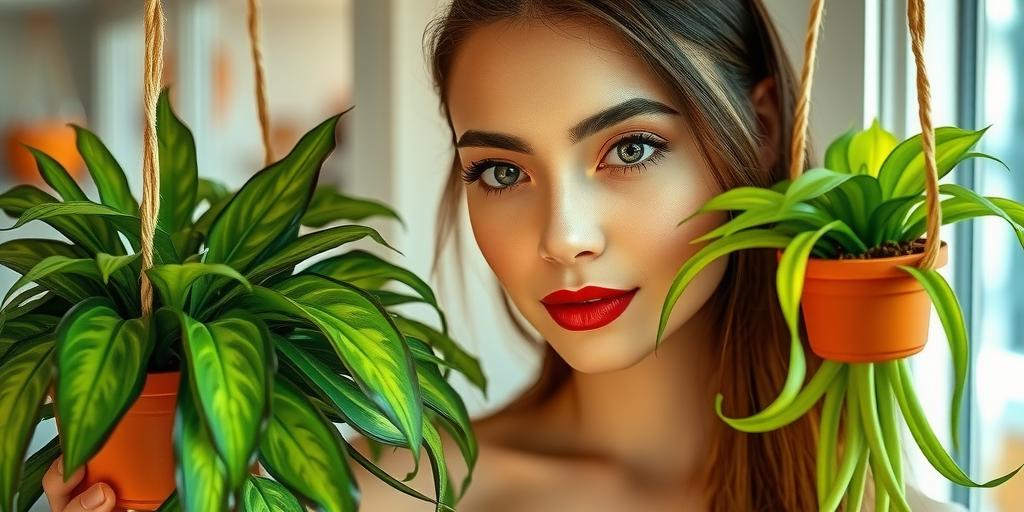
Low Light Hanging Plants for Beginners: Easy Tips for Thriving Indoor Greenery
Discover the best low light hanging plants for beginners! Learn care tips, ideal varieties, and how to keep them thriving in dim spaces. Perfect for indoor gardeners.
Introduction
Did you know some of the most beautiful houseplants thrive in low light? If you’re new to indoor gardening or have a dimly lit space, hanging plants can transform your home into a lush oasis—no sun required! Whether you’re decorating a shady corner or adding greenery to a north-facing room, low light hanging plants are forgiving, stylish, and surprisingly easy to care for. In this guide, we’ll walk you through the best plant picks, essential care tips, and creative ways to display them. Let’s dive in!
Best Low Light Hanging Plants for Beginners
If you’re new to indoor gardening and want to start with low-maintenance hanging plants, these five options are perfect for beginners.
Pothos (Epipremnum aureum)
Pothos is one of the easiest plants to grow, making it ideal for beginners. Its heart-shaped leaves come in various shades, from deep green to variegated gold and white. This plant thrives in low light but can adapt to brighter conditions if needed. Plus, it’s nearly indestructible—perfect if you forget to water it occasionally.
Spider Plant (Chlorophytum comosum)
Spider plants are another excellent choice for beginners. They produce long, arching leaves and tiny “pups” (baby plants) that dangle from the mother plant. These pups can be easily propagated to grow new plants. Spider plants tolerate low light well and help purify the air, making them both beautiful and functional.
Philodendron Heartleaf
With its fast-growing vines and heart-shaped leaves, the Philodendron Heartleaf is a great low-light hanging plant. It’s adaptable and forgiving, thriving even in less-than-ideal conditions. If you want a lush, trailing plant without much effort, this one’s a winner.
Peperomia
Peperomias are compact, making them ideal for small spaces. They come in a variety of textures—some have thick, waxy leaves, while others have rippled or striped foliage. These plants don’t need much light and prefer to dry out slightly between waterings, so they’re perfect for forgetful plant parents.
String of Hearts (Ceropegia woodii)
If you love delicate, trailing plants, the String of Hearts is a stunning option. Its slender vines feature small, heart-shaped leaves with silver marbling. While it prefers bright, indirect light, it can tolerate lower light conditions—just expect slower growth.
How to Care for Low Light Hanging Plants
Even though these plants are low-maintenance, they still need proper care to thrive. Here’s what you should keep in mind.
Watering
The biggest mistake beginners make is overwatering. Most low-light hanging plants prefer their soil to dry out slightly between waterings. Stick your finger about an inch into the soil—if it feels dry, it’s time to water. If it’s still damp, wait a few more days. Overwatering can lead to root rot, which is often fatal.
Light Requirements
While these plants tolerate low light, they still need some light to survive. Bright, indirect light is ideal, but they can manage in dimmer spots. Avoid placing them in complete darkness, as this will stunt their growth and cause leggy, weak stems.
Fertilizing
During the growing season (spring and summer), feed your plants with a diluted houseplant fertilizer once a month. In fall and winter, reduce or stop fertilizing since growth slows down. Over-fertilizing can harm the roots, so always follow the instructions on the label.
Pruning
If your plant starts looking leggy or sparse, don’t be afraid to trim it back. Pruning encourages bushier growth and keeps the plant looking full. Simply snip off any excessively long vines or yellowing leaves with clean scissors.
Pest Control
Dust buildup on leaves can attract pests like spider mites. Wipe the leaves occasionally with a damp cloth to keep them clean. If you notice pests, treat them early with insecticidal soap or neem oil to prevent infestations.
Creative Ways to Display Hanging Plants
Hanging plants can transform any space into a green oasis. Here are some stylish ways to display them.
Macramé Hangers
Macramé plant hangers add a bohemian touch to any room. They come in various designs, from simple knotted styles to intricate woven patterns. Hang them near a window or in a corner to create a cozy, nature-inspired vibe.
Wall-mounted Shelves
For a cascading green wall effect, install floating shelves and arrange multiple hanging plants at different heights. This works especially well in small spaces where floor space is limited.
Ceiling Hooks
Maximize vertical space by installing ceiling hooks. This keeps plants out of the way while adding visual interest overhead. Just make sure the hooks are secure enough to hold the weight of the plant and pot.
Glass Terrariums
If you love humidity-loving plants like ferns or moss, glass terrariums are a great option. They create a mini greenhouse effect, keeping moisture levels high while showcasing your plants beautifully.
Ladder Displays
A wooden ladder leaned against a wall makes a charming plant display. Hang small pots from the rungs or place trailing plants on each step for a tiered, garden-like effect.
Common Mistakes to Avoid
Even with easy-care plants, mistakes can happen. Here’s what to watch out for.
Overwatering
This is the #1 killer of houseplants. Always check the soil before watering—most low-light plants prefer to dry out a bit between waterings. If the leaves turn yellow or the soil smells musty, you might be overdoing it.
Placing Plants in Complete Darkness
While these plants tolerate low light, they still need some light to photosynthesize. A completely dark corner will cause weak, stretched-out growth. If natural light is scarce, consider using a grow light.
Using Pots Without Drainage Holes
Drainage is crucial to prevent root rot. Always choose pots with holes at the bottom, or use a cache pot (a decorative outer pot) with a nursery pot inside.
Ignoring Dust Buildup on Leaves
Dust blocks sunlight and can attract pests. Wipe leaves gently with a damp cloth every few weeks to keep them clean and healthy.
Forgetting to Rotate Plants
Plants grow toward the light, which can lead to uneven growth. Rotate your hanging plants every few weeks to ensure all sides get equal exposure and stay balanced.
By avoiding these common pitfalls and following basic care tips, your low-light hanging plants will thrive and bring life to your space effortlessly.
Conclusion
Low light hanging plants are a beginner-friendly way to bring life into any space—no green thumb required! With the right varieties (like pothos or spider plants) and simple care routines, you can enjoy lush, trailing greenery even in dim corners. Ready to start? Pick a plant, grab a hanger, and let your indoor jungle thrive!
